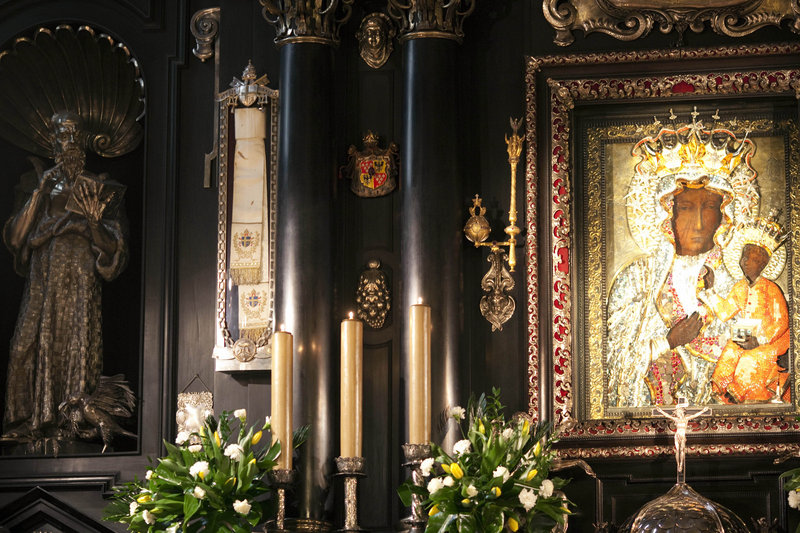WARSAW, Poland – Pope John Paul II is not yet a saint, but objects donated by his longtime secretary are already being venerated as relics in his staunchly Roman Catholic homeland.
Polish Formula 1 driver Robert Kubica keeps a medallion containing a fragment of the late pontiff’s robe and a drop of John Paul’s blood given to him by Krakow’s Archbishop Stanislaw Dziwisz after a high-speed accident at a race in Italy.
At the Sanctuary of Our Lord’s Divine Mercy church in Krakow, a new altar also will include a vial of the Polish Pope’s blood donated by his secretary and friend.
The relics are just one sign of Poles’ devotion to their homegrown pope, who served 27 years, and was put on the fast-track for sainthood after shouts of “Santo subito!” — or “Sainthood immediately!” — erupted during his funeral Mass at St. Peter’s Square in Rome.
Though beatification, the last major step before possible sainthood, is still six weeks away on May 1, many Polish Catholics already revere him for his religious devotion and as a national hero who helped bring down communism.
But some critics reject the veneration of relics, saying it smacks of medieval or pagan practices. Others say that by introducing relics into the public cult of John Paul, Dziwisz is reducing the memory of a complex and multidimensional figure to simplistic mementos.
“Relics were needed in times when people could not read or write,” said the Rev. Krzysztof Madel, a Jesuit priest in Nowy Sacz, near Krakow, who has spoken out against the promotion of the relics. By placing a vial of John Paul’s blood in the altar of a church in Krakow, he argued, “we will return to the Middle Ages and magic-based Catholicism.”
The veneration of relics goes back to the early days of Christianity, when gatherings were sometimes held secretly on graves of martyrs to avoid persecution. Once Christians were freer to worship churches were built inside cities, but the remains of martyrs were deemed indispensable and were brought to the churches.
Over time, objects like alleged pieces of the cross upon which Jesus was crucified, the bones of saints or even what was purported to be John the Baptist’s head brought pilgrims to cathedrals in droves, providing an important source of revenue. And Poland already has its share, including the mummified head of a 17th-century martyr, which is inside a glass coffin at Warsaw’s St. Andrzej Bobola’s church.
This week Warsaw resident Maria Michalczyk stopped by the church, named for the saint, to pray at the relic, saying she was asking him to intercede on her behalf with God.
“I have already experienced so many acts of mercy from him,” the 59-year-old said.
Zbigniew Mikolejko, a historian of religion with the Polish Academy of Sciences, argued that John Paul’s memory would be better served in a less spectacular way. The church should promote the pope’s teachings or teach about his life, which was shaped by the suffering under the German occupation during World War II, the hardships of communist-era life, poverty and the loss of his mother early in his life, Mikolejko said.
He was a “contemporary man who lived through dramatic times and should be seen as a symbol of that collective fate” rather than treated as a “source of magical practices,” the historian said.
Amid the outpouring of criticism, Dziwisz has defended his introduction of the relics.
“Unnecessary polemics have surrounded these relics, revealing a lack of knowledge of history and of church traditions,” Dziwisz said in early March.
“The blood of the Holy Father is the greatest relic which has remained with us, an expression of his enormous love and attachment to us, as well as an opportunity to be united to the person that we loved. Our prayer to God is made easier through the Blessed person” he said.
The blood that will be built into the altar in Krakow church was drawn for medical tests at Rome’s Gemelli Polyclinic shortly before John Paul’s death on April 2, 2005, and is now in Dziwisz’s possession, according to Piotr Sionko, the spokesman for the John Paul II Center, a religious complex encompassing Lagiewniki. The blood is to be encased in the altar after the beatification, Sionko said.
Dziwisz has not spoken publicly about whether there is more blood in his possession or why he chose to hold onto the blood taken for medical purposes from the dying pontiff. His office has so far declined requests by The Associated Press for interviews.
With John Paul’s body entombed at the Vatican, the faithful in Poland say they will welcome any relics they can get.
John Paul II is a “saint and deserves to be preserved for us so we can go and pray and ask him for God’s favors,” said Irena Anders, an 89-year-old from Warsaw who feels relics are very important because they create a sense of “greater closeness” to the departed revered person.
Other objects linked to his life are already major draws, including the childhood home in Wadowice, where the pope was born Karol Wojtyla, and the sash stained with his blood during a failed attempt on his life in 1981, now on display at the shrine of Jasna Gora in Czestochowa.
Send questions/comments to the editors.



Success. Please wait for the page to reload. If the page does not reload within 5 seconds, please refresh the page.
Enter your email and password to access comments.
Hi, to comment on stories you must . This profile is in addition to your subscription and website login.
Already have a commenting profile? .
Invalid username/password.
Please check your email to confirm and complete your registration.
Only subscribers are eligible to post comments. Please subscribe or login first for digital access. Here’s why.
Use the form below to reset your password. When you've submitted your account email, we will send an email with a reset code.